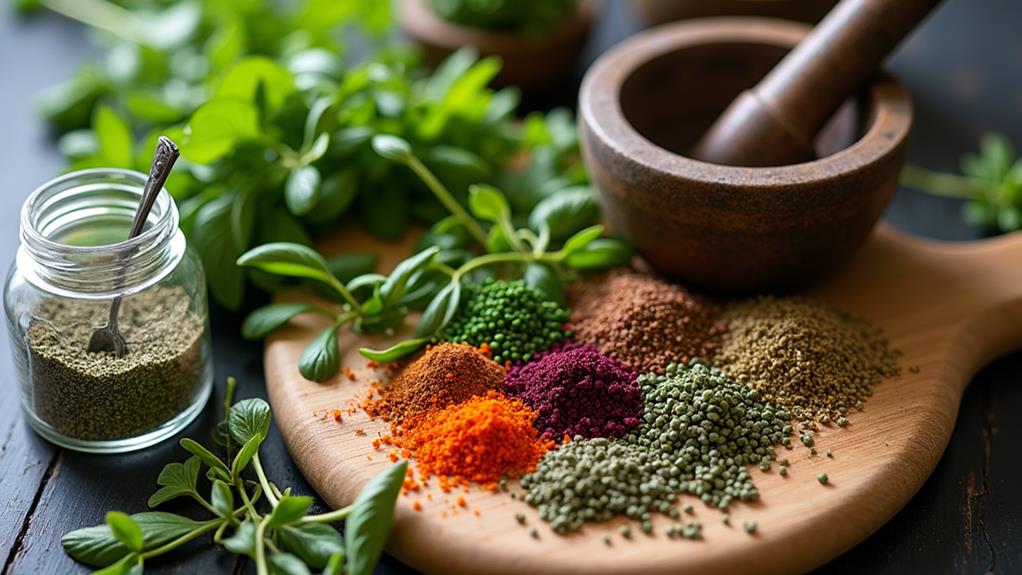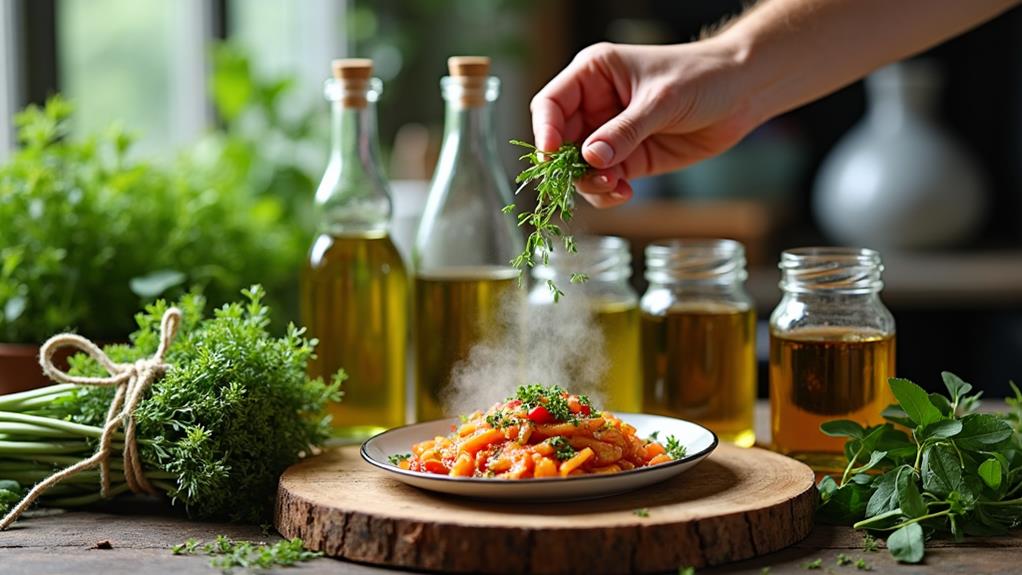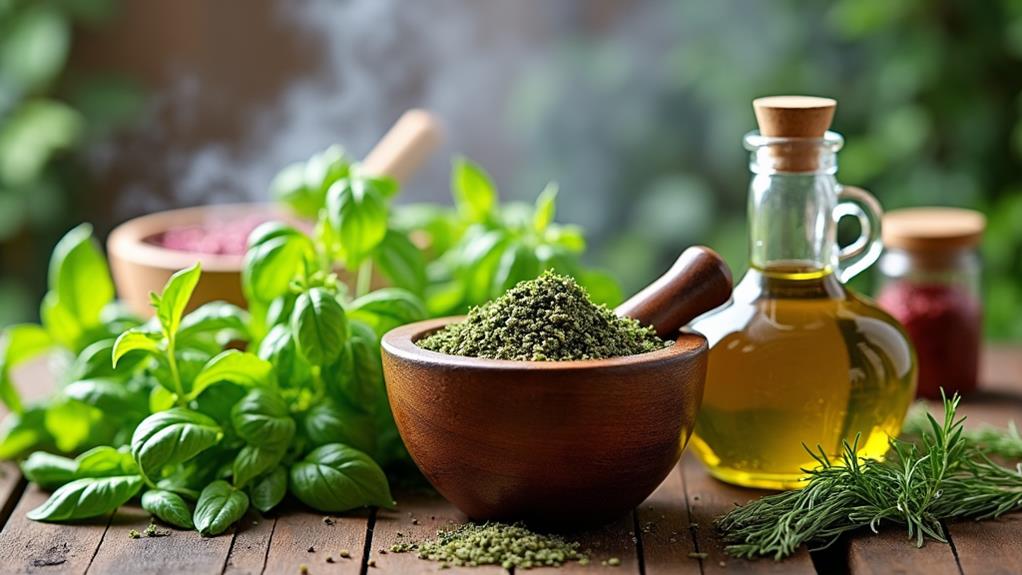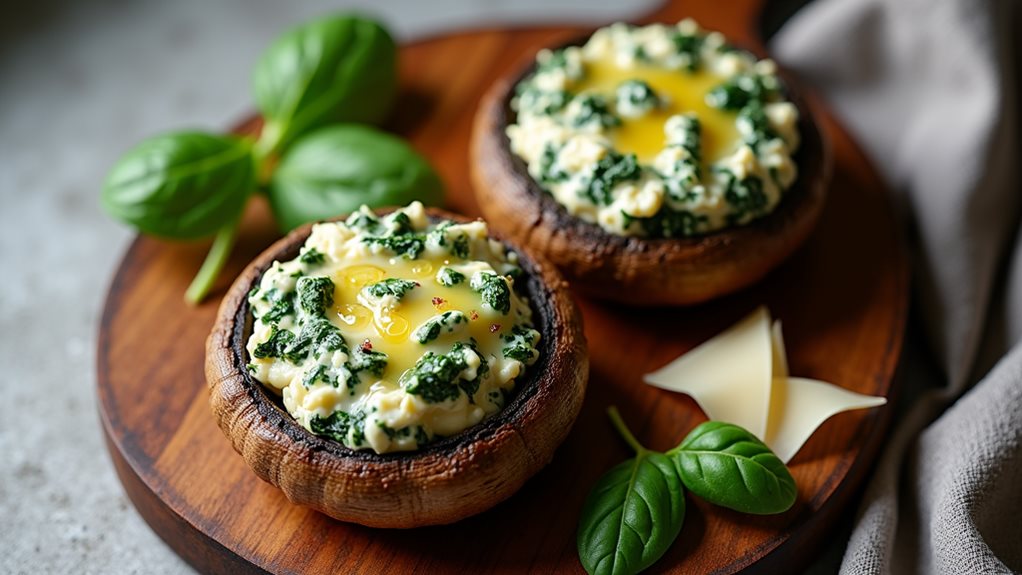To spice up your dishes with herb infusions, start by selecting aromatic herbs that complement your cuisine. Master the infusion process by choosing between hot, cold, or oil methods, adjusting temperature and steeping times for optimal flavor extraction. Experiment with blending and grinding techniques to create unique flavor combinations, using tools like mortar and pestle or electric grinders. Store your infusions in airtight, dark containers and get creative with their applications, from dressings to marinades. Finally, pair your infused herbs thoughtfully with dishes, enhancing both savory and sweet recipes. These techniques will elevate your cooking, transforming everyday meals into gourmet experiences.
Selecting the Perfect Aromatic Herbs
When selecting aromatic herbs for infusion, consider both their flavor profile and medicinal properties. Your herb selection can dramatically impact the final taste and health benefits of your culinary creations. For instance, lentils with spring greens can be enhanced with fresh herbs, making your dish both nutritious and flavorful.
Start by exploring classic options like basil, thyme, and rosemary, which offer versatile flavor profiles that complement a wide range of dishes. Then, branch out to more exotic choices such as lemongrass, sage, or tarragon to add unique twists to your infusions.
Pay attention to the intensity of each herb's aroma and taste. Robust herbs like oregano and mint can quickly overpower other flavors, so use them sparingly. Delicate herbs like chervil or cilantro may require larger quantities to impart their subtle notes.
Consider combining herbs with complementary flavor profiles to create complex, layered infusions. For example, pair earthy thyme with bright lemon balm for a balanced blend.
Don't forget to factor in the medicinal properties of your chosen herbs. Many aromatic plants offer health benefits beyond their culinary uses. Chamomile can promote relaxation, while rosemary may improve cognitive function.
Mastering the Infusion Process
Infusion mastery begins with understanding the basic principles of extracting flavors and beneficial compounds from herbs. To elevate your culinary creations, you'll need to explore various infusion methods and perfect your temperature control.
Start by selecting your preferred technique: hot infusion, cold infusion, or oil infusion. Each method offers unique benefits and flavor profiles, allowing you to tailor the process to your specific herbs and desired outcomes. For instance, fresh herbs like mint can provide a refreshing twist in salads such as Cucumber Mint Salad, enhancing both flavor and presentation.
For hot infusions, bring water to a near-boil and pour it over your herbs, letting them steep for 5-10 minutes. This quick method works well for delicate leaves like mint or chamomile.
Cold infusions, ideal for more robust herbs, involve steeping at room temperature or in the refrigerator for several hours or overnight.
Oil infusions require gentle heating of your chosen oil with herbs, then straining and storing the flavored result.
Temperature control is crucial across all methods. Too hot, and you'll destroy delicate compounds; too cool, and you won't extract enough flavor.
Experiment with different temperatures and steeping times to find the sweet spot for each herb combination, unlocking their full potential in your innovative dishes.
Blending and Grinding Techniques

Three key techniques elevate your herb-infusion game: blending, grinding, and crushing. By mastering these methods, you'll unlock a world of flavor combinations and enhance your culinary creations.
For instance, experimenting with fresh herbs can infuse dishes like Herby Spring Chicken Pot Pie with vibrant flavors. Start by experimenting with herb ratios, combining complementary flavors like rosemary and thyme or basil and oregano. For optimal results, use fresh herbs whenever possible and adjust proportions to suit your taste preferences.
When it comes to grinding methods, you have several options at your disposal. A mortar and pestle offers precise control and releases essential oils effectively, while electric grinders provide speed and consistency for larger batches.
For a coarser texture, try using a rolling pin or the back of a spoon to crush herbs gently. Each grinding technique imparts a unique character to your infusions, so don't hesitate to mix and match methods.
Zesty Storage and Usage Tips
Preserving the vibrant flavors of your herb infusions is crucial for long-lasting enjoyment. To maintain freshness and potency, store your infusions in airtight, dark glass containers away from direct sunlight and heat. Label each container with the herb type and infusion date for easy reference.
When it comes to creative herb applications, don't limit yourself to traditional uses. Experiment with incorporating your infusions into unexpected dishes and beverages to elevate your culinary creations.
Here are some innovative ways to use your herb infusions:
- Add a splash of lavender-infused oil to homemade ice cream for a unique floral twist
- Use rosemary-infused vinegar as a base for a refreshing summer cocktail
- Drizzle thyme-infused honey over roasted vegetables for a savory-sweet combination
For fresh herb preservation, consider freezing your infusions in ice cube trays. This method allows you to portion out small amounts as needed, ensuring that the flavors remain intact.
When using frozen infusions, simply pop out a cube and let it melt at room temperature before incorporating it into your recipe. By following these storage and usage tips, you'll maximize the potential of your herb infusions and take your cooking to new heights.
Pairing Infused Herbs With Dishes

Countless culinary possibilities await when you pair infused herbs with the right dishes. To elevate your cooking, consider the flavor profiles of both your infused herbs and the main ingredients in your recipe.
For robust herb pairings, match rosemary-infused olive oil with roasted lamb or potatoes. The oil's intense aroma complements the meat's richness while enhancing the crispy exterior of the potatoes.
When working with delicate flavors, opt for subtler infusions. Basil-infused vinegar can brighten a Caprese salad or add depth to a light pasta dish. For seafood, try using dill-infused oil to impart a fresh, tangy note to grilled fish or shellfish.
Don't shy away from unexpected combinations. Lavender-infused honey can transform desserts, adding a floral complexity to fruit tarts or ice cream. In savory applications, it pairs beautifully with roasted chicken or root vegetables.
Frequently Asked Questions
Can I Use Dried Herbs Instead of Fresh for Infusions?
You can absolutely use dried herbs for infusions! They're often more concentrated, so you'll need less. Experiment with different ratios to achieve your desired flavor intensity. Don't be afraid to mix and match for innovative blends.
How Long Do Herb-Infused Oils Typically Last Before Spoiling?
Did you know 60% of homemade infusions spoil prematurely? You'll extend your herb-infused oil's shelf life by storing it properly. Keep it refrigerated in an airtight container, and you'll enjoy its flavors for up to 3 months.
Are There Any Herbs That Should Not Be Used for Infusions?
You'll want to avoid herbs with toxicity concerns like comfrey or wormwood. Instead, focus on safe herbs that'll enhance your infusion flavor profiles. Experiment with unique combinations to create innovative, aromatic blends that'll elevate your culinary creations.
Can I Use Herb-Infused Oils for Skincare or Aromatherapy Purposes?
You're about to revolutionize your skincare routine! Yes, you can slather herb-infused oils on your skin like a mad scientist. Embrace the herb benefits and oil properties for aromatherapy too. You'll be a walking, aromatic innovation in no time!
What's the Best Way to Strain Herbs From Infused Liquids?
You'll elevate your herb infusion techniques with these cutting-edge straining methods. Try a fine-mesh sieve for clarity, or experiment with cheesecloth for ultra-smooth results. For maximum innovation, consider using a nut milk bag or coffee filter.
Final Thoughts
You've now unlocked the secrets to herb-infused culinary magic! With these techniques, you'll transform ordinary meals into extraordinary feasts that'll make your taste buds dance with joy. Your kitchen will become a fragrant oasis, bursting with vibrant flavors that'll leave your guests begging for more. Remember, the key is experimentation – don't be afraid to mix, match, and create your own unique blends. Soon, you'll be crafting dishes that rival those of master chefs!















